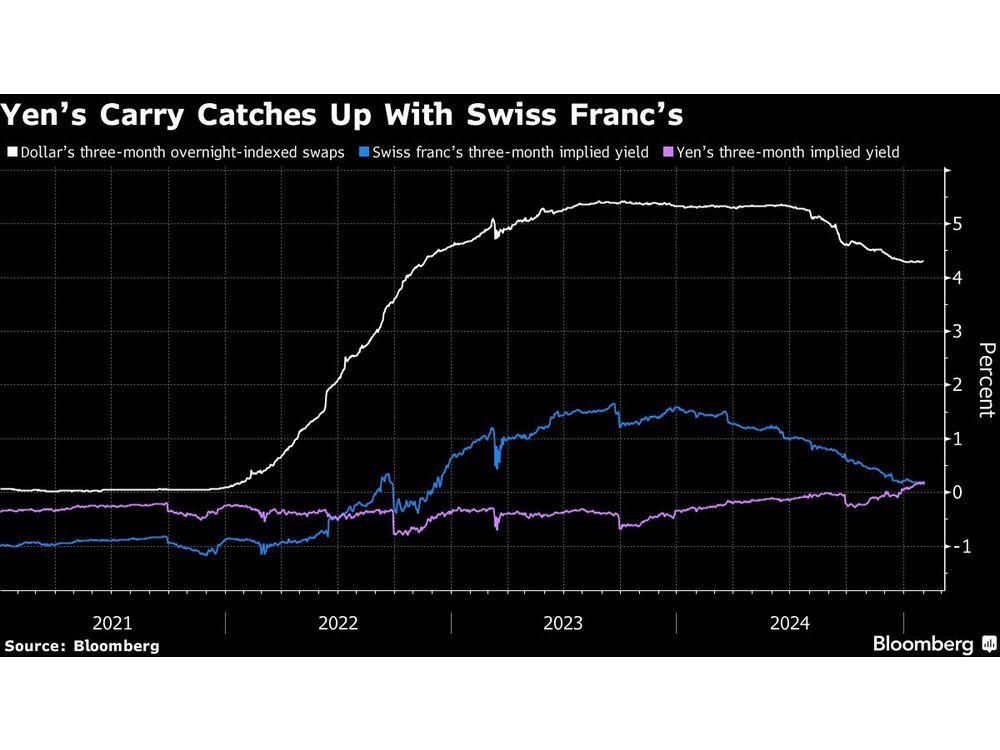
Article content
(Bloomberg) — The yen withstood the worst of the dollar’s onslaught on Monday after President Donald Trump imposed new tariffs, suggesting that investors still see value in the Japanese currency as a haven in times of turmoil.
Article content
It advanced as much as 0.3% against the greenback before trading 0.4% lower at 155.76 per dollar at 10:12 a.m. in Tokyo. The euro was down more than 1% versus the US currency, as were the Canadian, Australian and New Zealand dollars.
Article content
The yen’s relative resilience Monday isn’t a one off. It’s the only Group-of-10 currency to remain higher versus the greenback this year. Elsewhere, signs of flight from risky assets were evident in the declines in equity markets across Asia after Trump carried out his threat to impose general levies of 25% on Canada and Mexico and 10% on Chinese goods, starting on Tuesday.
READ: Investors Buy Dollars, Brace for Stock Slide as Trade War Begins
“The yen is rediscovering its safe haven credentials,” said Gareth Berry, a strategist at Macquarie Bank Ltd. in Singapore. It’s mainly due to the Bank of Japan being on a hiking path, “but also US Treasury yields are now so elevated that they dip on risk-off, and that sends dollar-yen lower,” he said.
The yen’s course so far in 2025 stands in contrast to its weakening over the past four years, as the wide interest rate gap between Japan and the US kept it under near-constant pressure.
What Bloomberg strategists say…
“Amid Monday’s steep selloffs in a slew of currencies, the Japanese yen is standing out as a relative oasis of calm. The yen is the only G-10 currency advancing versus the dollar right now, with traders likely to be leaning into its performance during the first Trump presidency when it attracted attention by climbing when most of its peers fell.”
Article content
— Garfield Reynolds, Markets Live strategist. Read more on MLIV.
A stronger yen may now give the BOJ more leeway when deciding to add to its recent series of interest rate hikes, thus narrowing the rates gap with the US. Following its increase last month, the central bank is likely to wait until around July to September before its next move, according to economists surveyed by Bloomberg.
“The yen is a safe asset,” said Akira Takei, a fixed-income manager at Asset Management One Co. in Tokyo. “Up until now, wages have been rising, but with the yen weakening, import prices have been high and it’s been difficult for the BOJ to raise rates. With that factor gone, there’s no need to rush rate hikes.”
The dollar still retains its yield advantage versus the yen, but Japan’s currency is making gains against others as a haven such as the Swiss franc.
The yen’s so-called carry — as measured by three-month forward-implied yields — climbed above zero in late December and has since reached that of the franc for the first time in more than two years.
“The yen is so cheap and the franc is so strong that the yen is preferred,” said Berry. “It helps the yen’s case too that the BOJ is still in tightening mode,” while the Swiss central bank is easing, he said.
—With assistance from Takahiko Hyuga.
Share this article in your social network